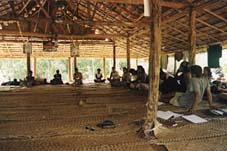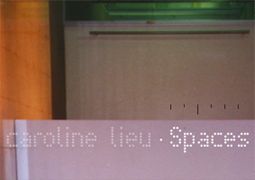The unifying spirit of design
We talk to Australian designer Monib Mahdavi about graphic design, typography and his faith
MONIB MAHDAVI, who has just taken up a post as senior designer for David Trewern Design in Melbourne, is a professional whose work is to make us look beyond the surface. His aims are not just in design, but are geared towards making us realize our societies' and our world's potential.
This more meaningful approach to design has seen Mahdavi create memorable pieces, including several notable typefaces. His claim to add substance and to get audiences fulfilling their 'material, intellectual and spiritual capacities' is not just hype either, for Mahdavi is a follower of the Bahá�í faith, an objective of which is to awaken people's spiritual capacities, assisted through service to humanity.
Bahá�í ideology is based around unity, and, in Mahdavi's words, 'that the nine major religions of the world are essentially part of a single progressive relationship, and have therefore sought their guidance from a single "source".' This has seen Mahdavi seek inspiration not just from the design world, but from devoting seven months of 1999 to be a voluntary worker on the Solomon Islands.
'The best forums for design education often come from indirect experiences outside of the profession. My time there was intentionally non-career and non-design-related.
'The experience was a flip side on life as I knew it. Through the new everyday processes such as sleeping in leaf huts, living off the land and travelling by canoe, I encountered fresh observations and perspectives on ways to fulfil necessities.

Teaching in the Solomon Islands
|
Additionally, working with the sole objective of helping people develop their skills, talents and global awareness has given me new insights on how to broaden the scope of my own design work.
'I think I am a much sharper designer and look forward to channelling my time towards more non-profit work to ensure that my purpose as a designer is maximized.'
He suggests that design students look at doing the same to enable them to become better skilled. Creativity and technological savvy could be aided by 'an element of acquaintance with their spiritual existence and responsibility. Maybe our commercial interests have desensitized us.
'I am not implying that we should all close up shop and head for the forest. There are many avenues for service, some local and some remote, but I see that the solution to our world's shortcomings lies in a collective understanding of the fact that we are essentially spiritual by nature. Within this untapped capacity lies limitless new means for creating moral and social development through design, technology or any arena for that matter.'
Monib Mahdavi found himself in design not through personal service initially, but through a 'deep interest'. 'I was always intent,' he explains, 'on becoming either a designer or a tennis player. I couldn't maintain the sporting devotion to drive a young fledgling tennis career, so eventually I came to terms with the cold, hard truth that I would never cut it at tennis.'
His mother's occupation as a painter helped with his visual education. 'As a child I would spend hours making stencies, and cutting up newspapers and rub-down lettering to make typo-montages for my own experimentation. I recall once creating a back-lit sign saying "design", made from coloured transparency film. Switching my light on would illuminate the letters via a connected wire. I humbly thought I had created a design consultancy.'
He also grew up living close to a train line, and the graffiti influenced him.


Monib Mahdavi�s work for Nike, Caroline Lieu
|
He still enjoys the 'aggressive focus' on letterforms.
Mahdavi entered the profession at a young age, as a graphic designer at a photography studio and a typography lecturer at the University of South Australia. The latter position was in his final year where he taught students below him. The age difference with his students was, therefore, not great, creating what he calls a 'motivating environment', sharing theory with his students' practical applications.
It is said that teaching others enables you to teach yourself more fully: the best understanding comes from re-expressing what one has learned. This was true for Mahdavi, constantly reiterating the fundamental principles and processes of design.
His teaching experience was not confined to familiar, western institutions. His time on the Solomon Islands included teaching, learning new social and cultural norms as well as Solomon Pijin, a form of broken English spoken alongside local dialects. Pictograms and visual aids were used where words did not extend, forcing Mahdavi to deconstruct and translate a concept to a foreign audience.
'I can't help but see a strange irony in my experience there,' he says. 'Coming from a background of designing for print, digital type and the web, to then find myself standing in a leaf hut in a remote village, using a white rock and blackboard to teach people about social issues. It was an unforgettable experience in channelling my creative energies beyond their visual means, and a potent reminder of where my true responsibilities lie.'
Many readers will have already encountered Mahdavi's work unwittingly: his fonts. As a commercial typeface designer, Mahdavi has been highly successful. His works have appeared as custom jobs for award-winning client accounts and as commercial typefaces for T-26.
He sees himself as a designer first�one who makes type�rather than a type designer who happens to design.
On an everyday basis, Mahdavi seeks inspiration from as many sources as possible, 'whether they be examples by fellow designers or artists, or scrawls, degraded letterforms or just marks on a footpath.'
Flux, a design available via T-26, came from experimentation with legibility at university. Sketches turned to digital outlines, and then the family itself. Flux Sans was later developed for extended text.
Other typefaces, which can be seen on his site, include the temporarily named Mahdavi, his first serif text design, and Vardon Sans, which initially existed as a few custom-drawn characters and 'deserved further development.'
Designing type has its challenges. There are what Mahdavi calls the fundamental principles that are not dependent on the medium, such as aperture, pattern, colour and consistency. When designing for print, he does not think about the medium unless the brief requires it, but designing for screen presents a new set of challenges.
The first is the screen. 'We are slaves to the resolution and probably will be for some years to come until high-res monitors/TVs/pods become the norm. In the meantime, there is a need for well-hinted fonts and well-made bitmaps. Advances in TrueType hinting have a lot of potential and I'm looking forward to the development of easier-to-use tools for designers who are not familiar with raw instructions. In addition, there is an obvious need for standardized technologies that support giving advanced typographic specifications for the web.'
He sees another irony in that designing for the screen takes one further back to the basics in defining a glyph and then representing that on a limited grid of pixels. This restricts the designer from adding superfluous detail but some differentiation is still required. 'I find it a humbling exercise to sometimes have only a few pixels in height to work with. Designing for print, on the other hand, with the accuracy and detail possible, offers much greater flexibility.
'These few ideas still only relate to the design of type itself. How the type is going to be used is another issue all together and just as important. Given the proliferation of screen-based information it poses a great responsibility to designers who are the ones dictating the delivery of the information. We are challenged with the task of wise selection and wise execution but a quick poke around the web reveals that most are still rolling dice.'
Mahdavi's faith will continue to drive him as he heads into his new position in Melbourne. It has already steered him on an adventurous journey in design, reading like the biography of a man who has experienced decades in the profession. Yet as a 24-year-old Mahdavi combines great experience with youth, open-mindedness with the fundamental tenets of Bahá�í. For the future, he foresees a practical and progressive step for all of us. 'Envisioning the unification of the earth's inhabitants isn't a utopian vision but rather, as asserted in the Bahá'í writings, "it constitutes the next, inescapable stage in the process of social evolution, a stage toward which all the experience of past and present is impelling us." Given our transition into the new millennium and all the hype that has accompanied it I am look forward to seeing designers play their role.'

Home | Contents | Features
Your feedback is welcome